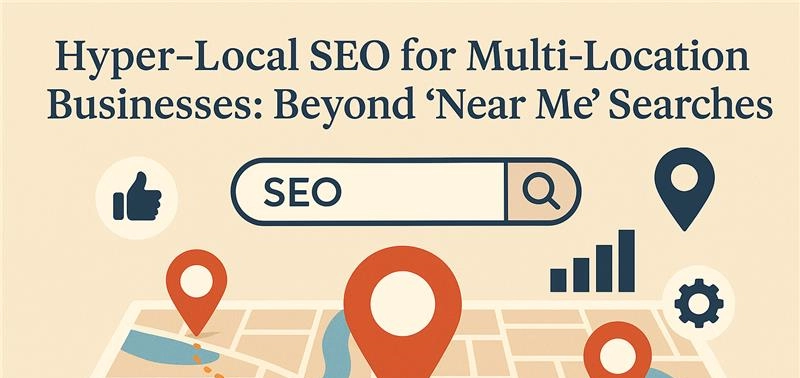Hyper‑Local SEO for Multi‑Location Businesses: Beyond ‘Near Me’ Searches
04 Nov 2025Local search has developed by 2025 into something much more than a mere query of a coffee shop near me. The current consumers seek real-time, personalized, and hyper-local results that have an answer to their precise location, time of the day, and even the weather. In the case of multi-location businesses, it is not the time to rely on the traditional approach of local SEO, but to develop a hyper-local SEO approach that targets every neighbourhood, community, and street corner that your brand caters to.
Regardless of being a retail chain, healthcare provider, or restaurant franchise, learning to master multi‑location SEO and optimize each Google Business Profile (GBP) would help gain visibility and increase foot traffic by far. Now, what about the next level of local search strategy? past the near me searches.
Why Hyper-Local Matters in 2025
The manner in which individuals search has been transformed. Hyper-local SEO has become the future thanks to voice assistants, AI-based search engines, and local search personalization. Search results are now customized by Google according to micro contexts - not only geography, but also time, weather, and local events.
For example:
- The query that a user may pose is, Best pizza near me open at this time of night at midnight.
- During rainy days, it becomes flooded with questions, such as what are some of the cozy cafes around?
- Searches for parking near XYZ arena, food stalls near Republic Park, etc., explode through the local festival.
The changing search trends imply that business needs to optimise not only on keywords, but also intent and context.
Optimising Google Business Profiles
A successful multi-location SEO is based on your Google Business Profile optimization. Every single business location should have its own confirmed and optimized listing. The following is how to maximize it.
1. Ensure Accurate NAP Details
Your Name, Address, and Phone Number (NAP) should be:
- 100 percent uniform in all listings, directories, and your website.
- No duplication or old-fashioned information.
- Structured using local schema markup on your site to help Google connect the dots.
Even simple differences such as "Street" and "St." may mislead algorithms and affect rankings.
2. Choose the Right Categories
Pick a primary business category that largely describes your central service and add other secondary categories to represent supplementary services.
Example: a pharmacy chain may make use of a pharmacy as a primary and a Health and Wellness Store as a secondary.
3. Add High-Quality Photos and Videos
Visuals drive engagement. Post pictures of your storefront, inside, staff, and merchandise. Provide location-specific images to distinguish between the branches and to reflect the surroundings.
4. Use the Q&A and Posts Features
Be responsive to frequently asked questions by customers, such as asking whether it has parking. Or does it open on Sundays, this branch?
Consistently post Google posts when promoting, hosting an event, or highlighting a local highlight. Such updates are an indication of activity and enhance visibility on local packs.
5. Keep Listings Updated
Holiday update times, seasonal offers, as well as quick response to user edits. New information assures Google of your business reliability - and your customers.
It is not just a listing but a digital business front on local search in a well-maintained Google Business Profile.
Managing Reviews & Ratings
The most important local ranking factor is your reputation. Local reviews and ratings affect the visibility and trust of customers.
1. Encourage Detailed, Keyword-Rich Reviews
Request content from customers to refer:
- The specific location (e.g., Trawlii Cafe at MG Road).
- Service or product delivered (e.g., "amazing espresso and Wi-Fi")
- Appropriate keywords (e.g., best coffee shop near me open late).
These naturally keyworded reviews assist Google in tying your listing to local search terms.
2. Respond Promptly and Professionally
Reward all reviews - good or bad. Show appreciation to customers with feedback, respond to problems in a constructive manner, and show them that you are committed to quality.
3. Monitor Sentiment Across Locations
In the case of multi-location businesses, monitor which of all the branches are mentioned in the most positive (or negative) ways.
Credibility and SEO performance are driven by customer feedback. The more genuine, descriptive, and location-oriented your reviews are, the better your business will be placed on hyper-local search.
Creating Neighbourhood-Specific Content
In order to win in hyper-local SEO, your content should be believable to every community. The generic posts will not work. You will have to create neighbourhood content marketing that will address the local audiences.
1. Create Local Landing Pages
Every branch should have its own optimized page featuring:
- Special title tags and meta descriptions that refer to the neighbourhood name.
- In-built Google Maps position.
- Local recommendations and contact information.
- A brief piece of local information (such as local attractions or events).
As an example, we should not say Our Stores but “Our South Delhi Cafe” or Visit Our Pune Baner Branch. This assists Google- as well as the users- in associating your brand with particular regions.
2. Publish Neighbourhood-Focused Blogs
We can write about -
- Local events, charitable events, or collaborations.
- Local folklore and places of interest.
- Trends (e.g., "Best summer drinks in Bandra").
Localized storytelling creates relevancy, creates backlinks, and increases visibility by site.
3. Leverage User-Generated Content
Ask the customers to post local pictures, tag your company, or use a special hashtag. Posting such content on your social profiles or blogs contributes to the aspect of authenticity and enhances the local search signals.
Tracking Success
A fact-based strategy will make sure that your hyper-local SEO strategy provides quantifiable results. Focus on:
1. Local Rankings
Monitor the performance of every location on its keywords (e.g., the dentist in Koregaon Park). Make use of such tools as Google Search Console, BrightLocal, or SEMrush.
2. Impressions, Clicks & Conversions
Track Google Business Profile Insights - searches, calls, direction calls, as well as visits. Add CRM or call tracking to bridge the gap between online presence and offline performance.
3. Reviews & Sentiment
Hyper-local SEO is concerned with continuous improvement - listening, optimization, and changing to the demands of the audience.
Prepared to expand your local presence? Enlist the services of the SEO team of Connect with Trawlii’s SEO team to ensure that your brand is visible in all neighbourhoods where you operate.




